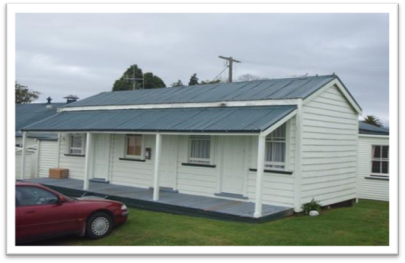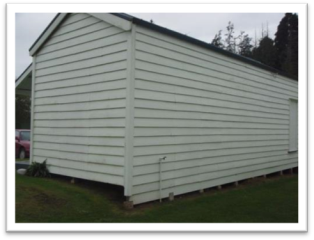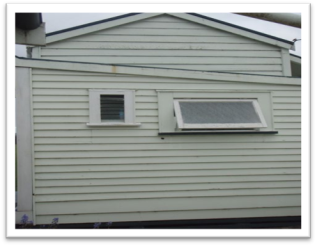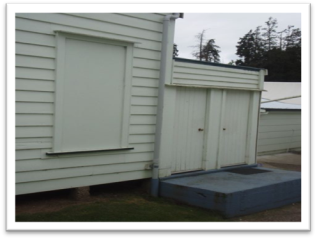HH-21: Okoroire Hot Springs Hotel – Staff Accommodation

Okoroire Hot Springs Hotel – Staff accommodation
Date of Photograph: 16/10/2008
Location and Zoning Information | |
Address |
18 Somerville Rd, Okoroire |
Current Owner |
Okoroire Hot Springs Hotel Ltd |
Legal Description |
Pt Lots 1 2 DP14395 & Pt Whaitikuranui 2E2 West 2B Blk XV Tapapa SD |
Zoning |
General Rural Zone – Part of SAL4 (Okoroire Precinct) |
Valuation Number |
541107400 |
Google Maps Link |
|
Architecture | |
Date of Construction |
1884 |
Materials |
Timber and corrugated iron. |
Architecture/Engineer/Builder |
Unknown |
Condition |
Good. Repairs undertaken to staff accommodation. |
Original Site Recommendation |
HNZPT Ref: 4233. Heritage Advisor, HNZPT. |
Current Use |
Accommodation and storage. |
Statement of Significance |
(1 Historical) - reflects important or representative aspects of South Waikato history, spa history, Okoroire Hot Springs and recreational history of South Waikato, coach stopover for coaches from the Okoroire railway station to Rotorua. Dates from periods of early settlement in South Waikato, (3 Community Association) - has important community association and public esteem, bathing and employment in the district (tourism). (7 Archaeology, pre 1900) - the site is protected under the Historic Places Act and has the potential through archaeological investigation to provide information about NZ and South Waikato history. (11 Context) - forms part of a wider historical and cultural complex, part of Okoroire Hot Springs. (13 Integrity) - good level of integrity. District Plan RulesDemolition - DIS. Protection focus - 1, 3, 7 and 11. Mitigate the effects of demolition by requiring the applicant to provide Historical Building Documentation (HBD) which should include: the structure history, photographic documentation and measurements of the item prior to removal. Alterations necessary for the primary purpose of improving structural performance, fire safety or physical access – CON -Refer to HH-R2. Other Additions/Alterations - DIS. Protection focus - 3 and 11. Effects can be mitigated/remedied through; a) HBD - See mitigating the effects of demolition. b) Design rules: 1.The overall visual character/shape of the original building should be identifiable. The addition should not dominate the existing building. 2.New work should be restricted to the rear of the building and not be evident from the road frontage. 3. The following special elements that are associated with the rarity or architectural uniqueness or craftsmanship of the structure should be retained: Elements of the structure that should be retained are those elements associated with its historic character, use, rarity, landmark values, craftsmanship, etc i.e. façade, exterior walls, openings chimney, landscape and any other elements identified in the Historic Building Documentation. c) Building materials rule: If repair of the structure is proposed the materials used for the exterior walls and elements should be similar in type, dimensions and profile as the existing exterior fabric of the building. Repair of the Structure - PER. Refer to HH-R1. Protection focus - 3 and 11. Building Materials Rule: If repair of the buildings is proposed the materials used for the exterior walls should be similar in type, dimensions and profile as the existing exterior fabric of the building. Design Rule: Repair and replication work should match the existing design and profile of element. Re-use/Change of Use - PER. Refer to HH-R1. Protection focus - 3 and 11. Internal Changes - DIS - simple building intact warrants control over interior changes. Relocation - DIS. Protection focus - 1, 3, 7 and 11. Mitigate the effects by 1) Consultation with the community and/or consultation with Iwi or special interest groups, 2) Relocate to a similar setting, 3) Documentation (HBD). Disturbance of the site surface/earthworks - Protection focus - 7. Note: Any place that was associated with human activity prior to 1900 and is able to provide evidence relating to the history of New Zealand is an 'archaeological site' (refer to definition of 'archaeological site' in Section 2 of the Heritage New Zealand Pouhere Taonga Act 2014). All archaeological sites are protected under the Heritage New Zealand Pouhere Taonga Act 2014 and approval from Heritage New Zealand must be obtained prior to destroying, damaging or modifying any site. Accordingly, where this site on which a building is located is an 'archaeological site' and the building is to be repaired, added to, relocated or demolished and this involves disturbance to the surface and/or subsurface of the site, approval from Heritage New Zealand is required. Surrounds - Part of a wider complex. Needs protection for context including open space and the trees identified in HINV20. Would want to manage effects on context of adding extra buildings DIS consent required (normal gardening, pruning and maintenance of tree health is permitted)
|
History |
Built for accommodation of staff working at the Okoroire Hot Springs Hotel. The complex was originally built as a luxury health and pleasure resort in 1884. Much of the main building was burnt down and rebuilt in 1915, however some of the original building is still standing. Set in a picturesque setting close to the Waihou River, the complex included 4 spacious hot spring bathhouses and a hall in addition to the hotel. It also provided recreational activities such as hunting, fishing and shooting and later golf as well. The hotel was a popular stopover for coaches travelling from the Okoroire railway station to Rotorua. The grounds contain many significant trees. (HNZPT).
|
Additional Photographs


